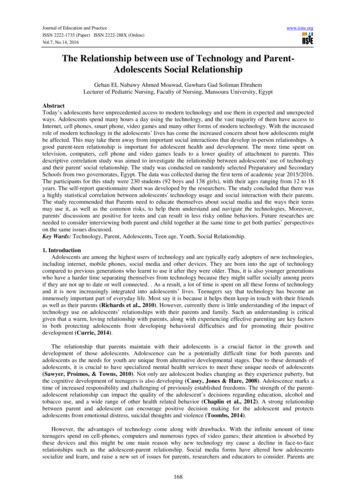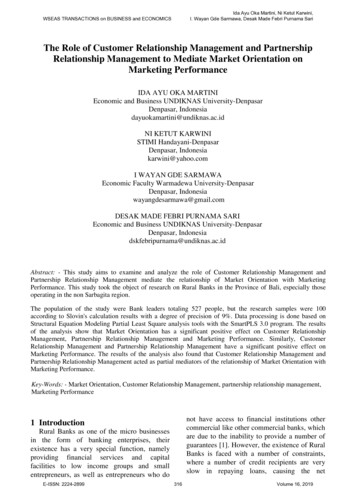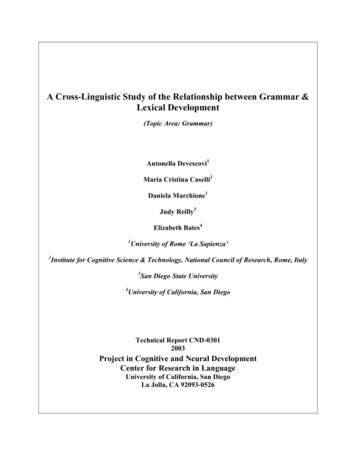
Transcription
Journal of Education and PracticeISSN 2222-1735 (Paper) ISSN 2222-288X (Online)Vol.7, No.14, 2016www.iiste.orgThe Relationship between use of Technology and ParentAdolescents Social RelationshipGehan EL Nabawy Ahmed Moawad, Gawhara Gad Soliman EbrahemLecturer of Pediatric Nursing, Faculty of Nursing, Mansoura University, EgyptAbstractToday’s adolescents have unprecedented access to modern technology and use them in expected and unexpectedways. Adolescents spend many hours a day using the technology, and the vast majority of them have access toInternet, cell phones, smart phone, video games and many other forms of modern technology. With the increasedrole of modern technology in the adolescents’ lives has come the increased concern about how adolescents mightbe affected. This may take them away from important social interactions that develop in-person relationships. Agood parent-teen relationship is important for adolescent health and development. The more time spent ontelevision, computers, cell phone and video games leads to a lower quality of attachment to parents. Thisdescriptive correlation study was aimed to investigate the relationship between adolescents' use of technologyand their parent' social relationship. The study was conducted on randomly selected Preparatory and SecondarySchools from two governorates, Egypt. The data was collected during the first term of academic year 2015/2016.The participants for this study were 230 students (92 boys and 138 girls), with their ages ranging from 12 to 18years. The self-report questionnaire sheet was developed by the researchers. The study concluded that there wasa highly statistical correlation between adolescents' technology usage and social interaction with their parents.The study recommended that Parents need to educate themselves about social media and the ways their teensmay use it, as well as the common risks, to help them understand and navigate the technologies. Moreover,parents' discussions are positive for teens and can result in less risky online behaviors. Future researches areneeded to consider interviewing both parent and child together at the same time to get both parties’ perspectiveson the same issues discussed.Key Wards: Technology, Parent, Adolescents, Teen age, Youth, Social Relationship.1. IntroductionAdolescents are among the highest users of technology and are typically early adopters of new technologies,including internet, mobile phones, social media and other devices. They are born into the age of technologycompared to previous generations who learnt to use it after they were older. Thus, it is also younger generationswho have a harder time separating themselves from technology because they might suffer socially among peersif they are not up to date or well connected. . As a result, a lot of time is spent on all these forms of technologyand it is now increasingly integrated into adolescents’ lives. Teenagers say that technology has become animmensely important part of everyday life. Most say it is because it helps them keep in touch with their friendsas well as their parents (Richards et al., 2010). However, currently there is little understanding of the impact oftechnology use on adolescents’ relationships with their parents and family. Such an understanding is criticalgiven that a warm, loving relationship with parents, along with experiencing effective parenting are key factorsin both protecting adolescents from developing behavioral difficulties and for promoting their positivedevelopment (Currie, 2014).The relationship that parents maintain with their adolescents is a crucial factor in the growth anddevelopment of those adolescents. Adolescence can be a potentially difficult time for both parents andadolescents as the needs for youth are unique from alternative developmental stages. Due to these demands ofadolescents, it is crucial to have specialized mental health services to meet these unique needs of adolescents(Sawyer, Proimos, & Towns, 2010). Not only are adolescent bodies changing as they experience puberty, butthe cognitive development of teenagers is also developing (Casey, Jones & Hare, 2008). Adolescence marks atime of increased responsibility and challenging of previously established freedoms. The strength of the parentadolescent relationship can impact the quality of the adolescent’s decisions regarding education, alcohol andtobacco use, and a wide range of other health related behavior (Chaplin et al., 2012). A strong relationshipbetween parent and adolescent can encourage positive decision making for the adolescent and protectsadolescents from emotional distress, suicidal thoughts and violence (Toombs, 2014).However, the advantages of technology come along with drawbacks. With the infinite amount of timeteenagers spend on cell-phones, computers and numerous types of video games; their attention is absorbed bythese devices and this might be one main reason why new technology my cause a decline in face-to-facerelationships such as the adolescent-parent relationship. Social media forms have altered how adolescentssocialize and learn, and raise a new set of issues for parents, researchers and educators to consider. Parents are168
Journal of Education and PracticeISSN 2222-1735 (Paper) ISSN 2222-288X (Online)Vol.7, No.14, 2016www.iiste.orgincreasingly trying to stay around their adolescents’ online lives and monitor their teenagers’ use of the internet.In addition, parents can help teens think about online presence in moral and ethical ways, specifically to helpteens in understanding the consequences for themselves and others of participation in the socially networkedworld (Carr, 2011).Most parents have positive relationships with their adolescents. However, parents now have to compete withthe technology that is a growing part of their adolescents’ lives. For example, youth may be using technology tospeak with their peers more often; this may widen the gap between themselves and their parents. Althoughtechnology and media have always been involved in adolescents’ lives, they play an even bigger role today.Parents already have to address the changes in their relationship with their adolescents, as their children’s peersbecome a higher priority; in addition, parents now have to account for the role that technology plays in theiradolescents’ lives (Subrahmanyam & Greenfield, 2008). Now that technology has become so salient inadolescents’ lives, it is speculated that it could be more difficult for parents to engage in open and honestcommunication with their children. Parents may have to compete with their adolescents spending more time withtheir peers and their adolescents’ increasing technology use. Limited research is available on how the addition oftechnology to adolescents’ lives affects the overall family dynamic and the adolescent-parent relationship(Toombs, 2014).2. Significance of the problemAdolescence is a fragile stage of development in which it requires special attention and care from parents. It wasfound that connectedness between parent and child during adolescence stage is crucial as it improves child lifesatisfaction and mental well-being. Closeness to parents was also found to prevent problems such asmaladjustment at school and needing care for emotional and behavioral issues (Ciairano, Kliewer, Bonino &Bosma, 2008). Over the past decade, technology has become increasingly important in the lives of adolescents.As a group, adolescents are heavy users of newer electronic communication forms. They are using thesecommunication tools primarily to reinforce existing relationships, both with friends and romantic partners(Subrahmanyam & Greenfield, 2008). Moreover, the technological revolution that has occurred in recent yearshas impacted on daily life within a family in a variety of different ways. New media technologies have becomeembedded in today’s society and have resulted in major societal changes. One of the main social settings thathave been affected is that of the family.3. Aim of the StudyThe aim of this study was:To investigate the relationship between adolescents' use of technology and their parent' social relationship4. Research hypothesis:The adolescents who use modern technologies more would have negative social interaction with their parents.5. Research question:As adolescents become quick and intuitive technology users. They become more independent from their parentsand spend more time on modern technology, have raised questions about the use of this technology. Animportant question which this paper tries to address is how modern technologies affect their relations with theirparents?6. Research methodology:6.1. Research design: A descriptive correlation design was used.6.2. Setting:The study was conducted on randomly selected Preparatory and Secondary Schools from two governorates(Dakahlia and Gharbia), Egypt. The data was collected during the first term of academic year 2015/2016.6.3. Sampling:The participants for this study were 230 students (92 boys and 138 girls), with their ages ranging from 12 to 18years.6.4. Tools for data collection:I- A self-report questionnaire sheet:The self-report questionnaire sheet was developed by the researchers. It was written in simple Arabiclanguage, based on a review of literature relevant to the problem and by reviewing previous studies (Hair et al,2003), (Khan, 2011), (Kemp, 2012), (Schulz, 2013), (Toombs, 2014) and El Kiweri & Al Ghamdi, 2015). Itwas reviewed and validated by an expertise panel in pediatric nursing. The questionnaire was concerned withgathering data related to:169
Journal of Education and PracticeISSN 2222-1735 (Paper) ISSN 2222-288X (Online)Vol.7, No.14, 2016www.iiste.org1) Characteristics of adolescents and their parents as age, sex, birth order, residence, and educational levelof their mothers and fathers.2) Ownership of adolescents for different technology as TV, computer, mobile phone, internet and videogames, (as how many hours they spent in using those technologies, with whom they are watching TV,in which things they use computer or mobile phone).3) Adolescents’ perceptions regarding their parents opinion in relation to adolescents' usage of TV,computer, mobile phone, internet and video games. It consisted of short 15 items; each item was ratedon 5 points Likert scale.4) Adolescents’ perceptions in relation to the influence of using different devices of technology on theirsocial relationship with their parents. It consisted of short 15 items; each item was rated by Yes or No.6.5. Ethical consideration:Written permissions from the directors of selected schools were obtained before conducting the study.Adolescents were informed about the purpose and use of the study, their privacy was assured and their oralconsent was gained. The questionnaire sheet was filled out by the participants. Each participant took about 15minutes to complete the survey individually.6.6. A pilot studyWas conducted on 50 adolescents, in order to insure the feasibility and validity of the tools, modifications weredone as necessary. Rephrasing in some statements were done in order to achieve the aim of the study. Subjectswho shared in the pilot study were excluded from the main study sample.7. Results:The data was revised, coded, tabulated, and presented using descriptive statistics in the form of frequencies andpercentage for qualitative variables, means and standard deviations for quantitative variables. Qualitativevariables were correlated. Correlation is significant at the 0.05 and 0.01 levels. Statistical analyses wereperformed using the SPSS (Version 19.0) software.Table (1) illustrates that, the age of more than two third (64.3%) of the studied sample ranged from 17 to18 years. Regarding sex, (60%) of them were girls. In relation to birth order; the ranking of 40% of adolescentsare the first and about half (51.3%) of them lived in urban area. The majority of fathers and mothers hadBaccalaureate degree of education (76.5% - 73.5%) respectivelyTable (2) shows that, more than half (53.1% - 54.8%) of studied sample watching TV from one to twohours and watching it alone. 75.2% of adolescents having either computer, laptop or tablet computer and themajority (85.6%) spend from 2 to 4 hours using it. 79.6% using computer for Facebook and other sites of socialmedia. 77.8% of them having smart phone and 71.7% using mobile phone to talk with parents while 14.3%reported that Internet helps to maintain close relationships with parents. In addition, (16.5%) of them spendfrom 6 to 8h per week in playing video games/ play station or X box. 40.9% of them reported that they havebetter relationship through the Internet. More than half (54.8%) stated that they are talking to their parents morethan one time per day.Figure (1) it is observed from this figure that, most adolescents reported that their parents are allowing themto watch what they want on TV. On the other hand, small number of adolescents stated that their parents arekeen to watch a specific TV program or drama with them.Figure (2) indicates that, most of adolescents reported that, their parents give them a sufficient amount ofaffection, give them advices about their way of using mobile or internet, they use the mobile phone to talk totheir parents, their parents observing their way of using / talking on mobile or internet and their parents dealingwith them as a responsible person. Meanwhile, small number of them said that, it is easy for them to tell theirimportant secrets to their parents and added that they use the internet to talk with their parents.Table (3) clarifies that more than half of adolescents stated that using of technology, namelycomputer/Internet and TV followed by mobile phone and these using effect on their social values/ethics andchange their communication skills and their way of communication. A bout two third of them added that theseacquired behaviors and communication skills, their parents not accept it. More than half of them reported that,they became able to take decisions to satisfy their needs without reference to their parents after the use ofcomputer/ Internet and TV. The majority of adolescents reported that, they acquired behaviors of disobedience totheir parents after use of technology; they found that their use of technology is the best way to express theminstead of talking to their parents. Moreover, they added that, using of technology is reduced the time they spendwith their parents and using of technology give them warmth, love and support in most of their relationships(these influence regarding computer/Internet and mobile phone).Figure (3) shows that, the highest percent of adolescents (48.7%) has moderate social relationship withtheir parents.170
Journal of Education and PracticeISSN 2222-1735 (Paper) ISSN 2222-288X (Online)Vol.7, No.14, 2016www.iiste.orgTable (4) shows that, that there was a highly statistical significant correlation between adolescents' use ofcomputer/internet and mobile phone as revealed by (P. 0.01, P. 0.001) respectively. While, there was nostatistical correlation between adolescents' use of TV and their social relation with their parents.Table (1): Descriptive statistics of adolescents and their parents (n 230).CharacteristicsFrequencyAge in years12 - 14 Y14 - 17 YFrom 17 to 18 YPercent2912.65323.114864.316.0957 1.83833Mean S DSexBoyGirlBirth orderFirstSecondThirdFourth and moreEducational background of adolescents’ fatherPrimary/IlliterateTechnical degreeBaccalaureate degreeEducational background of adolescents’ motherPrimary/IlliterateTechnical degreeBaccalaureate 11848.751.3Table (2): Characteristics and distribution of using technology by the Adolescents (230)ItemsRelated to TVWatching TV from 1 to 2 h/dayWatching TV aloneWatching TV with familyWatching TV with friendsRelated to computer / laptop or tablet computerHaving one of theseUsing computer from 2 to 4 h /dayUsing computer for Facebook and other sites of social mediaUsing computer for doing their homeworkRelated to mobile phoneHaving smart phoneUsing mobile phone from 3 to 5 hUsing mobile phone to talk with parentsInternet helps to maintain close relationships with parentsTime spent in video games (either through computer or mobile) / play station or X boxfrom 10 to 12h per weekI have better relationship through:Mobile phone (calls and messages)The Internet ( social .312152.6479420.440.9Direct contact8938.7Times of talking to the parentsNot talkingOnce per month16376.916.1Once per week5122.2More than one time per day12654.8171
Journal of Education and PracticeISSN 2222-1735 (Paper) ISSN 2222-288X (Online)Vol.7, No.14, 2016www.iiste.orgFigure (1): Mean of adolescents’ perceptions in relation to T.VFigure (2): Mean of adolescents’ perceptions in relation to mobile, computer/ Internet172
Journal of Education and PracticeISSN 2222-1735 (Paper) ISSN 2222-288X (Online)Vol.7, No.14, 2016www.iiste.orgTable (3): Adolescents’ perceptions in relation to the influence of using different devices of technology ontheir social relationship with their parents (n 230)Technology DevicesItemsComputer /Mobile phoneTVinternetNo.%No.%No.%Using of technology effect on my social12654.89240.012152.2values/ethicsUsing of technology help me to acquire behaviors14864.311349.113558.7and communication skills, my parents not accept itAfter using technology, my communication skills13357.811148.311657.0was changedI was feeling lonely before the use of technology9340.49039.18938.7Using of technology reduced my feeling of loneliness10746.59039.18537.0I became socially enclosed after use of technology7934.37733.56930.0I was a dependent personality on my parents before10746.59541.38637.4the use of technology to satisfy my needs and takemy decisionsI became able to take decisions to satisfy my needs13056.511047.812152.6without reference to my parents after the use oftechnologyI was an obedient to the orders of my parents before18580.417977.816672.2the use of technologyI acquired behaviors of disobedience to parents after16973.518379.63716.1the use of the technologyI found that my use of the technology is the best way11851.312353.51310.0to express myself instead of talking to my parentsUsing of technology is reduced the time I spend with13357.811851.39541.3my parentsUsing of technology help me to see myself from the15667.818178.7135.7perspective of othersUsing of technology give me warmth, love and16973.519283.52711.7support in most of my relationshipsMeans of technology help me to overcome the loss of 11349.114663.53314.3someone dear to meFigure (3): Percentage of extent of adolescents' social relationship with their parents173
Journal of Education and PracticeISSN 2222-1735 (Paper) ISSN 2222-288X (Online)Vol.7, No.14, 2016www.iiste.orgTable (4): Correlation of using different devices of technology with adolescents relationship with theirparents (n 230)ItemsExtent of adolescents closeness with theirparents (Relationship with their parents)Computer / internetT- testP. value11.69 0.01Mobile phoneT- testP. value26.69 0.001TVT- testP. value0.020.888. DiscussionAcross time, parent-adolescent relationships have been complicated by the developmental needs ofadolescents, and parents’ struggle to respond appropriately to these needs. In recent years, with the increased usetechnology, an interest in its social impact on everyday life has developed (Odendaal et al, 2006). Concern isgrowing that adolescents’ extensive use of electronic communication to interact with their peers may impair theirrelations with their parents, siblings, and other family members. There is some evidence that electronic mediamay enhance peer relations at the expense of family, especially parent-child relations (Subrahmanyam &Greenfield, 2008). As adolescents become quick and intuitive technology users and become more independentfrom their parents, what is the relationship between their perceptions of their communication with their parentsand their technology use (Toombs, 2014)? However, research on the use of different devices of technology andparents relationship is slight. This study can be seen as an attempt to start filling this gap in the literature. Thegoal of this study was to investigate the relationship between adolescents' use of technology and their parent'social relationship.The data from this study indicated that (75.2%) of adolescents having computer, laptop or tabletcomputer and (77.8%) of them having smart phone. This result is similar to the researches work reported by(Lenhart et al, 2010) who study teens & mobile phones, found that 75% of all teens own a cell phone. AndKhan (2011) who examined the relationship between duration of adolescents’ technology use and therelationship with their parents found that, 98.4% of adolescents have a computer at home and (84.1%) ownedcell phones. Moreover, Pew Internet and American Life Project, (2012) carried out a survey that exploredtechnology use among 802 youth ages 12 through 17. The study found out that, 78% of the teens have acellphone and almost half of them, 47%, own smart phones; 23% of the teens have a tablet computer, a levelcomparable to a general adult population; 95% of teens use the internet, and 93% of teens have a computer orhave access to one at home. In addition, Rossiter, (2012) who study children and parents: media use andattitudes, reported that, since 2011 smartphone ownership has increased among children aged 12-15 (62% in2012 vs. 41% in 2011). These findings suggest that overall ownership of technology is increasing even morerapidly every year.According to the present study, the majority (85.6%) of adolescents spent from 2 to 4 hours using thecomputer, 79.6% using computer for Facebook and other sites of social media. 40.9% of them reported that theyhave better social relationship with others through the Internet.71.7% using mobile phone to talk with parentswhile 14.3% reported that Internet helps to maintain close relationships with parents. These results are supportedwith the results of other researches findings as MacGill’s, (2007) who reported that, parents and adolescents findcell phones helpful and convenient because teens are able to communicate with their parents, let them knowwhere they are and get advice. In addition, Lenhart, Purcell et al, (2010) found that, 73% of online teens haveused a social networking site which is an increase from 55% 3 years earlier and added adolescents say they feelsafer with cell phone because they feel that they can contact their parent or get help whenever they need.Moreover, these findings corresponding with the findings of Khan, (2011) who found that, 68.3% participantsreported that their cell phone helps them maintain a close relationship with their parents, and only 27% ofadolescents said the internet helps them keep in touch with their parents. Also, Rossiter, (2012) reported thatchildren aged 12-15 are spending more time online (rising from 14.9 hours a week in 2011 to 17.1 in 2012) andnow they mostly use the internet in their bedrooms (43% in 2012 vs. 34% in 2011). The findings could mean thatcell phones facilitated a relationship between adolescent and parent when they were not in close proximity. Thiswould in turn lead to a better parent-teen relationship.This result is also agreed with Valkenburg & Peter, (2007) who stated that, as technology and theInternet are increasingly used for communication, and the use of socially interactive technologies has then alsosignificantly increased within the adolescent population. Ninety-three percent of all Americans between 12 and17 years of age use the Internet and 75% of these adolescents use the Internet for instant messaging. Moreover,Correa, Hinsley, & Zuniga, (2010) added that, the other predominant means of technology utilized for174
Journal of Education and PracticeISSN 2222-1735 (Paper) ISSN 2222-288X (Online)Vol.7, No.14, 2016www.iiste.orgcommunication purposes by youth is social networking. However, overly use Internet may neglect theinteractions with parents in the life, and even weaken the real-life relationships with their parents (Liu, Yin &Huang, 2013).In addition, the result of the present study is consistent with El Kiweri & Al Ghamdi, (2015) whofound that, 43.3% of the students surveyed used the computers for 1 hour up to 3 hours per day while 26 % ofstudents used the computers at least 3 hours per day. In regard to mobile phones 31.6% reported that they usedtheir phones 3 hours or more per day. Furthermore, Simuforosa, (2013) added that, today’s youth haveunprecedented access to modern technology and use them in expected and unexpected ways. Youth spend manyhours a day using the technology, and the vast majority of them have access to Internet, cell phones, smartphone, video games and many more.The findings of the present study showed that, 52.6% of adolescents spent from 10 to 12 hours per weekin playing video games. This finding is not congruent with(Khan, 2011) was found that 70.7% of the teenagersreported to spend less than 2 to 4 hours a day on video games. Meanwhile, a recent study reported that mostchildren and adolescents in Singapore between the ages of 10 to 16 years spent about 20 hours per week ongames (Choo et al, 2010). Wartella et al, (2013) added that, most parents rate video games as having a negativeeffect not only on children' social relationship but also on children’s reading, math, speaking skills, attentionspan, creativity, social skills, behavior, sleep and physical activity.The current study revealed that, more than half (54.8%) of adolescents stated that, they are talking totheir parents more than one time per day and 48.7% mentioned that they having moderate relationship with theirparents. This result is in contrast with Khan (2011) who found that 15.9% of the participants reported beingclosest to the adult (other than their mother or father) with whom they live. These teenagers are more likely tocontact their parents through cell phone.Television continues to play an important role in children’s lives, particularly for younger children. Itcontinues to be the media activity that the most children in all age groups say they do almost every day.Regarding adolescents' perceptions in relation to TV, computer/ Internet and mobile phone, the results of thepresent study revealed that, most adolescents reported that their parents are allowing them to watch what theywant on TV. On the other hand, small number of adolescents stated that their parents are keen to watch a specificTV program or drama with them. The result of the present study indicated that, most of adolescents reported that,their parents give them a sufficient amount of affection, give them advices about their way of using mobile orinternet, they use the mobile phone to talk to their parents, their parents observing their way of using / talking onmobile or internet and their parents dealing with them as a responsible person, Meanwhile, small number of themsaid that, it is easy for them to tell their important secrets to their parents and added that they use the internet totalk with their parents. These findings are consistent with Campbell, (2005) who mentioned that, the adoption ofthe mobile phone by young people has been a global phenomenon in recent years. It is now an integral part ofadolescents’ daily lives and is for the majority, the most popular form of electronic communication.Furthermore, Subrahmanyam & Greenfield, (2008) added that, parents are increasingly trying to stay aroundtheir adolescents’ online lives and monitor their teenagers’ use of the internet. However, despite parental controlsallowed by many types of technology, there are increasingly more ways out of parental control as well, that giveadolescents more and more autonomy. Overall it appears that despite parents' concerns about their teen’s onlineactivities, parents may not know much about them and may not be effective at setting limits and monitoring theiractivities. More research is needed to determine whether the problem is parents’ lack of knowledge about thesecommunication forms or their lack of parenting skills.These findings are also congruent with Jones & Fox, (2009) who stated that, technology and the Internethave become predominant factors in the lives of adolescents. Even in the short time that the technology has beenavailable, the reasons for using it have changed. With the trend of the last decade leaning toward using theInternet for educational research, surfing, shopping, and games; the current trend is communication, as 93% ofteens reported that their primary purpose for going online is for communication. Moreover, among cell phoneowning teens, voice calls are also a central function of their cell phones, especially for communicating with theirparents. One of the primary reasons parents allow their children to have cell phones is so that they may monitortheir location and stay in contact with them when they are not in close proximity. Adolescents and parents agreethat phones make their lives safer and more convenient but also mention disadvantages of cell phone use,especially the fact that they can result in irritating interruptions (Lenhart, Ling et al., 2010).175
Journal of Education and PracticeISSN 2222-1735 (Paper) ISSN 2222-288X (Online)Vol.7, No.14, 2016www.iiste.orgHowever, connectedness between parents and children of information age can be challenging due to theintergenerational gap. For children of information age, the Internet plays an important part in their lives in whichit is regarded as their new attachment figure as opposed to physical approximate-seeking behavior in infancy andchildhood. Consequently, as the Internet is playing an important role in lives o
The adolescents who use modern technologies more would have negative social interaction with their parents. 5. Research question: As adolescents become quick and intuitive technology users. They become more independent from their parents and spend more time on modern technology, have raised questions about the use of this technology. An











